Warehouses and other storage facilities require unique storage sprinkler solutions
An office building might have a similar square footage to a warehouse, but the two could not be more different to a fire protection engineer. That’s because warehouses present difficult hazards and require specially designed fire sprinkler systems and storage sprinklers. From the flammability of materials to rack and pile obstructions, warehouses have distinct issues from other commercial occupancies.
To meet these challenges, NFPA 13: Standard for the Installation of Sprinkler Systems (2022 edition) provides separate design criteria for warehouses and other storage facilities. Standard fire sprinklers are usually not adequate—storage fire sprinklers with large K-factors and specially designed deflectors are often necessary.
In this article, QRFS examines the specific issues of storage settings and how NFPA 13 categorizes them. Then, we outline the four sprinkler technologies developed to handle the challenge: CMDA, CMSA, ESFR, and in-rack sprinklers. Finally, we overview the way different variables in storage occupancies direct sprinkler system design in NFPA 13.
Whether you’re a contractor installing a storage sprinkler system or a building manager shopping for spare sprinklers, turn to QRFS for your CMDA, CMSA, ESFR, and in-rack sprinkler needs. Check out our ESFR models or contact us to discuss your equipment requirement and get a quote.
The unique challenge of warehouse fire protection
Warehouses can be dangerous places when it comes to fire. For example, in 2007, a fire broke out in a sofa showroom and warehouse facility, and nine firefighters were killed. That same year, a warehouse blaze in Warwickshire, England, killed three firefighters.
Multiple factors combine to create a high fire hazard in warehouses. Because of packaging materials, the goods stored are often highly flammable. Plus, the dense packing and high stacking of items can block water flow in a situation where high ceilings already make it harder to deliver water. Together, the features of storage occupancies create a very challenging situation.
Commodity class and extra-flammable fuels
In most commercial occupancies, flammability and fire hazard are assessed by categories called occupancy hazards. Listed in NFPA 13, these classifications are based on the kinds of activities in a structure. However, occupancy hazard categories aren’t sufficient for storage occupancies—they aren’t specific enough.
Commodity class provides a better picture of the fire hazard. It sorts the items stored in a warehouse based on their flammability, taking into account the goods themselves and any packaging materials. Packaging materials are very relevant to fire protection, as Styrofoam, plastic wrap, cardboard, and wood are all highly flammable.
NFPA 13 (A.20.3) outlines four commodity classes, plus special groups for plastics. Class I and Class II both contain noncombustible goods, with Class II generally having more combustible packaging materials. Class III and Class IV both include flammable goods, with Class III mostly involving wood, paper products, or natural fiber textiles. Finally, Class IV, the most flammable category, involves plastics.
NFPA 13 further divides plastics into separate groups (Group A, Group B, etc.), with Group A being the largest. In addition, special commodities like rubber tires and rolled paper get separate consideration.
“Encapsulation” is a particular packaging that can apply to any good that increases the fire hazard. It refers to palleted loads enclosed on the top and sides by a plastic sheet (3.3.68). The NFPA 13 Handbook explains that encapsulation prevents fuel from being wetted by sprinklers, allowing a fire to spread more easily. Therefore, NFPA 13 requires increased water flow for encapsulated commodities and limits how high they can be stacked.
Storage layouts can impede water spray
Flammability isn’t the only concern in storage situations—obstruction of sprinkler spray is a common problem. Accordingly, NFPA 13 takes storage arrangement into account, distinguishing different types of storage in great detail. We can’t get into every aspect in this article, so we’ll highlight the main distinction in these arrangements: rack storage versus piled storage.
Rack storage is a common way to store goods, and this category is broken down into open-rack and solid-shelf storage. Water can easily flow and drip through open-rack shelves, but solid shelving blocks it. Even finer details of rack storage come into play: the space between shelves and racks affects fire spread and water flow. Aisles between racks can create a fire break to control a blaze’s spread, while flue spaces between different rack compartments allow water to pass.
Instead of using racks, some goods are stacked directly on top of one another. This is referred to as “solid-piled” storage. When pallets are used to separate goods in such a stack, they are “palletized.” Solid-piled and palletized storage have distinct protection standards from rack storage.
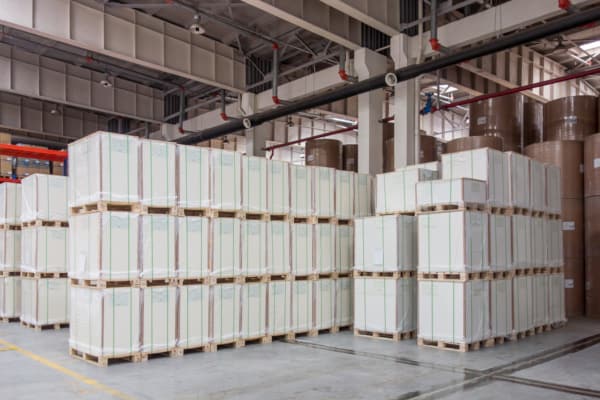
The effects of ceiling height and room size
Compared to warehouses, most commercial buildings have low ceilings and small rooms. Low ceilings make it easier for sprinkler spray to reach fires, and small rooms provide compartmentalization of fires, helping keep them in one area. But in warehouses, distance creates fire protection challenges.
Sprinklers have to spray water from very high ceilings, making it difficult to get water on a fire.
Additionally, warehouses usually don’t have much compartmentalization. Fire-resistant walls and ceilings typically help contain fires, and their absence can let blazes spread freely. An example of compartmentalization’s importance is NFPA 13’s provisions for storing unused plastic pallets—a major fire hazard. If the pallets are separated from other storage, the dedicated room must have three-hour-rated firewalls (20.17.2.2.4.1).
In-rack, CMDA, CMSA, and ESFR sprinklers meet the challenges of storage occupancies
A precise design approach is necessary to meet the challenges of these occupancies, an effort that includes using storage fire sprinklers.
The four main types of storage sprinklers are CMDA, CMSA, ESFR, and in-rack sprinklers:
CMDA: control-mode density area sprinklers
The “control-mode” in a control mode density area (CMDA) sprinkler refers to the fact that these heads provide wetting and cooling to control a fire until first responders can arrive. “Density-area” refers to how CMDA systems are designed. A set of density-area curves specifies the amount of water flow required for a given area. The system and its water source are engineered based on them to provide the necessary flow and pressure.
If this sounds familiar, it’s because CMDA sprinklers are almost identical to average fire sprinklers in both shape and function. Non-storage sprinkler design depends on density-area concepts, and these models produce similar spray patterns to CMDA sprinklers. The two things separating a CMDA sprinkler from a regular sprinkler are larger K-factors and higher temperature ratings.
The bigger K-factor in CMDA sprinklers (and most storage sprinklers) enables greater water flow. K-factor describes the size of the sprinkler orifice. The relationship between K-factor, water pressure, and water flow is described with a simple equation:
K = Q ÷
Where:
K=K-factor
Q=Flow in gallons per minute
P=Pressure in PSI
Thus, the bigger the K-factor, the more water can flow through a sprinkler at a given pressure.
You can read more about density/area concepts and sprinkler system design in our previous blogs.
CMSA: Control-mode special application sprinklers
Like CMDA sprinklers, control-mode special application (CMSA) sprinklers are designed for “control” functions: wetting and cooling to prevent fire spread. And like most storage sprinklers, CMSA sprinklers usually have large K-factors. However, they differ from CMDA sprinklers in two ways.
- CMSA sprinklers have unique sprinkler deflectors that produce different water droplet sizes and spray patterns. This makes CMSA sprinklers suited to “special applications;” in other words, high-challenge storage occupancies. The unique deflector also requires the sprinklers to carry a different listing.
- CMSA sprinklers don’t use the design concepts employed by CMDA sprinklers. No density/area curves are involved. Instead, different variables are analyzed to calculate the necessary flow and pressure for a given system.
ESFR: Early-suppression fast response sprinklers
Unique among fire sprinklers, early-suppression fast-response (ESFR) sprinklers provide fire suppression instead of fire control. The goal of ESFR sprinklers isn’t to prevent fire spread until firefighters can fully extinguish it. Rather, they are meant to activate quickly and attack a fire directly. The idea is that early fire suppression requires less total water, allows less fire spread, and ultimately makes sprinkler systems less expensive.
ESFR sprinklers have large K-factors and feature uniquely designed deflectors meant to produce large, high-momentum droplets that won’t evaporate before penetrating a fire plume. Another major distinguishing characteristic of ESFR sprinklers is fast-response elements designed to operate sooner than standard sprinkler elements.
You can read more about fast-response elements in our previous blog.
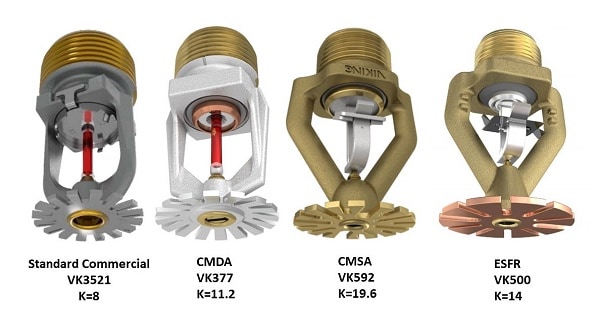
In-rack fire sprinklers
All the storage sprinklers we’ve presented so far have been ceiling-level sprinklers. But there are situations where tests have determined that ceiling sprinklers—no matter how large the K-factor or water pressure—can’t provide adequate control or suppression. Extremely flammable commodities, high ceilings, high-piled storage, and obstructions to water are common culprits. In these cases, in-rack fire sprinklers are necessary.
In-rack sprinklers work just like their name suggests: sprinkler risers and branch pipes are installed with storage racks to put sprinklers as close to potential fires as possible. Of course, doing so creates unique infrastructure challenges for warehouses—storage racks become more permanent when plumbing is involved. But it solves the issues posed by height and obstruction.
Little distinguishes an in-rack fire sprinkler from a traditional fire sprinkler. However, in-rack fire sprinklers are often installed with unique accessories, including cage guards and water shields. Cage guards protect sprinklers from heavy loads and machinery moving around them. Water shields protect in-rack sprinklers from the spray of other sprinklers. Water from a ceiling-level sprinkler head (or another in-rack head) could cool the heat-sensitive element of sprinklers near it, preventing them from operating as designed.
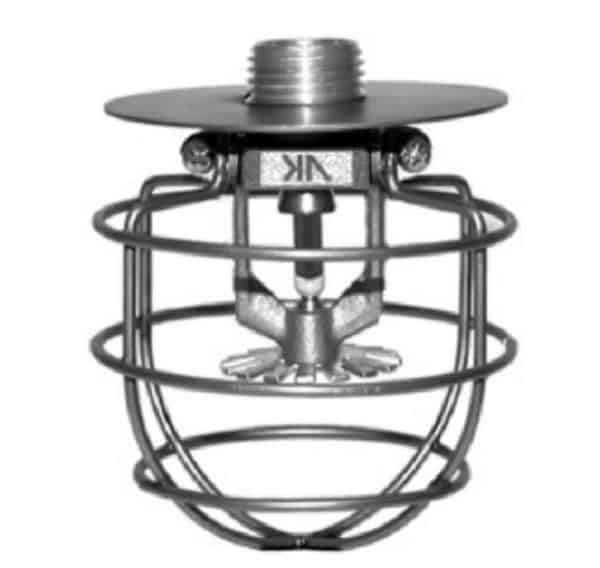
The design requirements for storage sprinkler systems are complex
As mentioned, designing most commercial sprinkler systems relies on density/area curves that determine how much water flow and pressure is needed. Selecting a curve depends on the occupancy hazard of a building. But while CMDA storage sprinkler systems use density/area curves, CMSA and ESFR systems aren’t based on this concept. Moreover, the decision-making process for a storage sprinkler system is much more complex.
Based on extensive empirical testing by FM Global, the design criteria for storage sprinkler systems consider many variables involved in a warehouse. And NFPA 13 guides the user through a decision tree based on the situation for each storage sprinkler system.
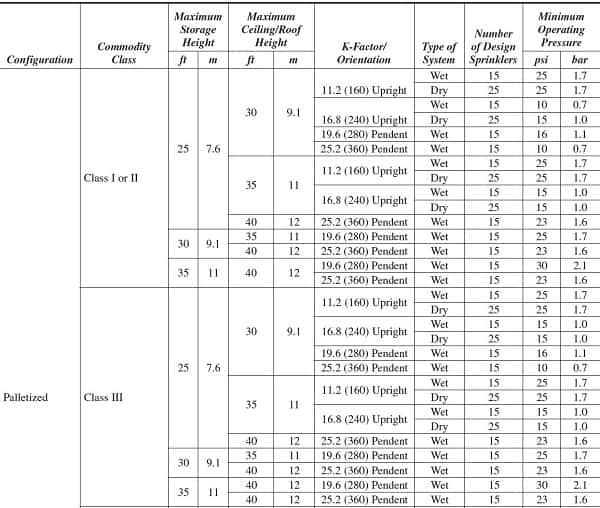
To understand what influences NFPA 13 rule, check out this test of ESFR sprinklers conducted by FM Global:
Storage fire sprinklers are specially designed to protect challenging environments
Again, warehouses and other storage occupancies present unique problems to fire sprinkler designers and engineers. High ceilings, obstructive storage arrangements, and highly flammable, densely stacked materials add up to increased fire danger.
Meeting these challenges calls for extra water flow and pressure, and it also requires special sprinklers. CMDA, CMSA, ESFR, and in-rack fire sprinklers were all developed to provide fire protection in storage environments. And they only work correctly within NFPA 13’s precise design criteria.
To purchase storage fire sprinkler heads and other equipment for this type of building, call us at +1 (888) 361-6662 or email support@qrfs.com.
This blog was originally posted at blog.qrfs.com. If this article helped you, check us out at Facebook.com/QuickResponseFireSupply or on Twitter @QuickResponseFS.


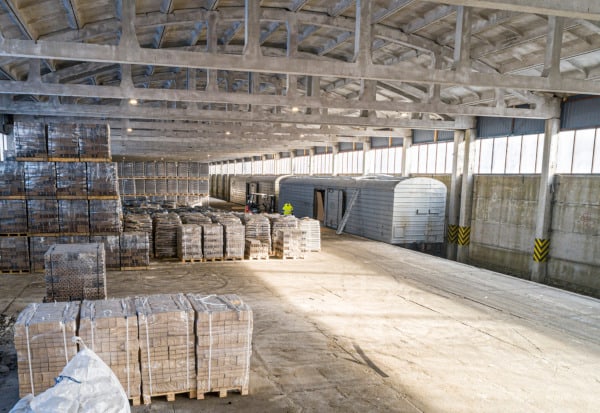
thus the warehouses uses same procedure of density area curve or if the outcome of water results to let say 1gpm/ft1, is this acceptable with higher ESFR and pressure as it almost above the design criteria as per density area graph.
Juditho — For system application questions like this, you can try our Ask a Fire Pro service. Click the link to submit your question with some information about your building and system, and a fire protection professional will provide an answer based on best practices, standards, and codes. Our pros include AHJs, contractors, engineers, and code experts with 150+ years of combined experience!
Great article! Easy to understand and will definitely send to applicants if wanting further information on the topic. Looking forward to reading more from you fine folks! Keep it up!
Thanks, Aaron!
Great, Highly Informative, I am bookmarking this site immediately.
Thanks, Rafiu!
AS PER NFPA 13 which sprinkler is suitable for 24 Mtr high bay warehouse for class I to IV commodities?
Kalpesh — That is a complex design question with an answer that depends on numerous variables. We suggest you contact a registered design professional to review the space in question. Thanks for reading.
Hi Kalpesh did you manage to find the answer to your question?
Very helpful post!
Interesting came across this comment supposedly added to annex material to address concerns that sprinklers were omitted from certain high bay areas and therefore did not meet the requirements of NFPA 13. The following text was added to Section A.8.1.1: “Based upon experience and testing, sprinklers have been found to be effective and necessary at heights in excess of 50 ft (15 m). For a building to meet the intended level of protection afforded by NFPA 13, sprinklers must not be omitted from such high ceiling spaces.”
Is there reference to such heights cause from the table 22.2 the heights do not exceed 12.2 for Class I Through Class IV Commodities?
Troy — We do not see an “A.8.1.1” in the current edition (2022) of NFPA 13. Annex A starts with A.8.1.1.2, which regards pressure gauges. What edition are you referring to?
Incredibly helpful post! Recently I have a client who wants to install fixed racking for storage of rubber tires, with piling height around 10m. Have you come across this case before, and what sprinklers type should we install? Much thanks!
Phong — NFPA 13 has a variety of rules for protecting rubber tires, including those governing maximum ceiling heights, maximum storage types, sprinkler types, and more in chapters 20 through 25 (2022 edition). Unfortunately, they are too complex and situation-specific for us to provide a sprinkler recommendation. You should consult a local fire protection pro to assess your needs. Thanks for reading.
Thank you – much appreciate for your kind inputs!
I have a large storage freezer (10,000 sq ft) 30′ ceiling with storage up to 25′ cardboard boxes on solid shelves. The piping will dry system exposed inside the freezer . Trying to determine the correct design area and density .. Does this have to be ESFR ?
Joe — Unfortunately, the design calcs and sprinkler, PSI, and flow considerations (especially for storage occupancies) are very complex and beyond our ability to provide guidance in this format. They are like a ‘Choose Your Own Adventure’ novel with many decision points and trees. You should consult with a design pro to assess the specific situation. Thanks for reading!